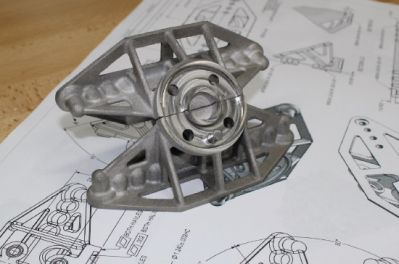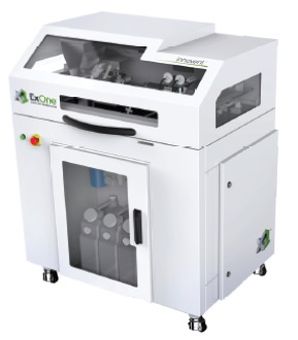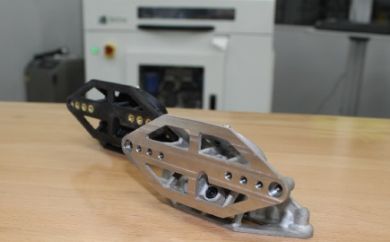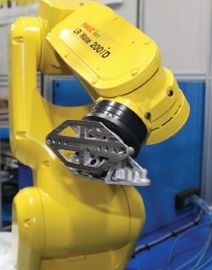Pa. Manufacturer Finds Binder Jet 3D Printing the Answer for Producing Durable, Lightweight End-of-Arm Tooling
Allegheny Electric was looking to develop a strong, lightweight end-of-arm tooling attachment for a high-volume precision inspection application with varying weight requirements. They found the solution in binder jet 3D printing.
Since 1985, Allegheny Electric has been involved in control systems design and industrial automation for the powder metal, lumber, and metal stamping industries. Allegheny Electric, a FANUC integrator, is committed to increase and improve their products using the latest technology available to provide practical solutions that will satisfy their customers' needs now and in the future.
The Challenge
Allegheny Electric needed durable and lightweight end-of-arm tooling for a robotic inspection process. A six-axis FANUC robot needed to pick up and place six different parts, of varying weights up to 2.5 pounds, for serial inspection running nonstop across three shifts. The number of parts being inspected in this factory environment ranges from 50,000 annually for the lowest-volume piece to 500,000 parts annually for the highest volume.

Allegheny Electric found that binder jet 3D printing this part was one-fourth the price of laser powder bed fusion.
The 3D printed piece was part of an assembly that needed to attach to two other end-of-arm tooling (EOAT) pieces that needed, in turn, to sit 90 degrees to one another for a variety of different inspection techniques.
Oftentimes, an EOAT solution developed by Allegheny Electric would be 3D printed in plastic, carbon fiber-reinforced plastic, or machined in a strong, lightweight material such as aluminum. Although an initial prototype was originally 3D printed in a carbon-reinforced plastic, the weight requirements and processing volumes for this project eliminated this material from consideration for the final production application for lack of durability.
"It would have had less life, and they couldn't afford the risk of dropping the part into the inspection station, which costs several thousands of dollars," explained Chris Aiello, VP of Business Development at FreeFORM Technologies, a first-of-its-kind metal binder jet 3D printing contract manufacturer founded in 2020 by a group of engineers. "The rigidity and strength just weren't there for the biggest parts."

An ExOne Innovent+ metal 3D printer was used to produce the final EOAT part in 17-4PH stainless steel.
Additionally, machining the desired functionality, even in lightweight aluminum, would have produced an EOAT part that would have been at the upper edge of weight for the FANUC robot arm being used, which was also not viewed as desirable.
Being an automation solution provider, Allegheny Electric wanted to explore whether metal 3D printing could offer weight and cost savings through new designs that could help them offer an innovative new solution to customers. The customer looked to both laser powder bed fusion, specifically DMLS, and binder jet 3D printing for a possible solution.
The Solution
Jake Shannon, Design Engineer at Allegheny Electric, approached Aiello to explore the options. Using generative software from Solid Edge, a CAD design and analysis software from Siemens, the two companies collaborated on a new lightweight design for the project that could only be produced with 3D printing.

A 3D printed carbon fiber- reinforced prototype, shown in black, was not rugged enough for use in the final application.
The design was quoted for both DMLS and binder jetting on an ExOne Innovent+, which is owned by FreeFORM Technologies. The part was quoted at $672 for DMLS, prior to any final finishing, and a comparable $150 on the Innovent+.
In binder jet 3D printing, the printer uses a digital file to quickly inkjet a binder into a thin layer of powder particles -- metal, sand or ceramic -- creating a solid part one layer at a time. When printing metals, the final part must be sintered in order to fuse the particles together into a solid object. Because binder jetting is so much faster than other metal 3D printing methods, such as laser powder bed fusion, it offers much lower costs that are more competitive with traditional manufacturing processes.
Binder jetting is also a sustainable method of manufacturing that reduces material waste to less than 5%, saves energy by consolidating many assembled parts and processes into one, and can deliver end-use designs that are 30-40% lighter -- for more efficient cars, planes, military equipment, and other applications.
In fact, Aiello said that the unique lightweight design generated in this case could not have been produced outside of a 3D printing technology. The company was also able to print a traditional stainless steel MIM powder, 17-4PH, with a D90 of 22 μm. This material was also desirable because of its durability and corrosion resistance, an important feature for the final part, which would be used in a factory with frequent temperature fluctuation.

The complex part designed in Solid Edge and 3D printed with binder jetting technology enables two tools to sit on the end of a robot arm at a 90-degree angle to each other.
Printed on an entry-level Innovent+, the final part exceeded MPIF standard 35, delivering a hardness of HRC 27 and final density of 98%. Because the hardness met the customer's requirements, additional heat treatment wasn't required. "They could have gone with a simpler design in aluminum, but the part would have actually been heavier to get the same strength as 17-4PH," Aiello said. "By going with this kind of organic generative design, they were also able to reduce the overall payload on the machine, so it's likely going to extend the life of the robot for the customer."
In this case, it was decided to machine three critical features, including a few holes and one surface for final flatness, to further dial in accuracy. Aiello noted that binder jetted parts take to machining just like standard metal materials. "It's very similar to machining wrought material," Aiello said. "It looks no different than a machined metal flat stock part." In all, the initial printing on the Innovent+ entry level system, with a build volume of 160 x 65 x 65 mm (6.3 x 2.5 x 2.5 in), took less than a day of printing in 50 micron layers of standard MIM powders.
The Future
While this project didn't have a high-volume part requirement for the final EOAT -- only four parts were initially needed -- Allegheny Electric Service was eager to do the project to explore whether binder jet 3D printing was ready to produce affordable parts in unique designs that could deliver higher performance in its automation applications.
Now, it has a new solution option to offer customers that can deliver durable, lightweight parts in metal at affordable prices. "We are always working within the design constraints of traditional manufacturing. Now we can focus on design intent and process optimization to meet or exceed our customers' expectations," said Jake Shannon, Design Engineer, Allegheny Electric Service. "We will definitely continue to offer our customers end of arm tooling produced with binder jet 3D printing. An important feature for us to offer our customers is how this technology reduced the payload on the robot."
For Aiello and the FreeFORM team, this project was an inspiration in how it showed the new design possibilities they can now offer in standard and durable metal materials at affordable prices.
Rate this article
View our terms of use and privacy policy ::m::